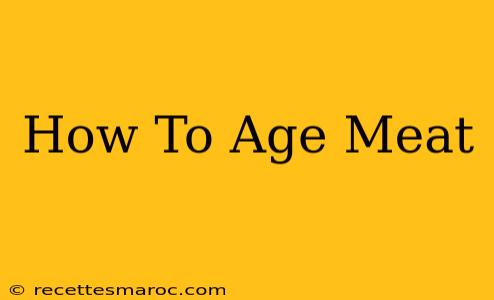Aging meat is a process that transforms a good cut into something truly exceptional. It's all about enhancing flavor, tenderness, and overall eating experience. But how do you do it? This comprehensive guide will walk you through the different methods of aging meat, from the basics to more advanced techniques. Whether you're a seasoned chef or a home cook just starting out, understanding the art of aging meat will elevate your culinary game.
Understanding the Aging Process
Meat aging is essentially a controlled decomposition process. Enzymes naturally present in the meat break down proteins, resulting in a more tender and flavorful product. This process also concentrates the meat's existing flavors. There are two primary methods: wet-aging and dry-aging.
Wet-Aging
This method involves vacuum-sealing the meat and storing it in a refrigerator. The meat's own moisture helps to tenderize it, but the process is less dramatic than dry-aging.
- Pros: Simpler, less equipment needed, less loss of weight.
- Cons: Less intense flavor development compared to dry-aging.
Dry-Aging
This is where the magic truly happens. Dry-aging involves exposing the meat to controlled temperature and humidity conditions for several weeks. This allows for significant moisture evaporation, concentrating the flavors and creating a uniquely intense taste. A noticeable crust will form on the surface, which needs to be trimmed before cooking.
- Pros: Develops a much more intense and complex flavor profile, creates a desirable crust.
- Cons: Significant weight loss (up to 20%), requires specialized equipment or ideal environmental conditions.
Choosing Your Meat
The success of meat aging depends heavily on the quality of the starting material. Opt for high-quality cuts of beef, such as ribeye, New York strip, or tenderloin. The better the quality of the meat, the better the results after aging.
Equipment and Supplies for Dry-Aging
Dry-aging at home requires specific conditions to prevent spoilage. Consider these essentials:
- Refrigerator with adjustable temperature and humidity: Ideally, you need a refrigerator that can maintain a temperature between 34-38°F (1-3°C) and a humidity level around 80%. Some specialized aging refrigerators are available.
- Aging chamber or bag: These specialized containers help maintain consistent humidity and protect the meat from unwanted bacteria.
- Meat thermometer: Essential for monitoring the internal temperature of the meat throughout the aging process.
The Dry-Aging Process: A Step-by-Step Guide
-
Preparation: Select a high-quality cut of meat. Trim excess fat and remove any blemishes.
-
Aging: Place the meat in your chosen aging chamber or bag. Maintain the optimal temperature and humidity.
-
Monitoring: Regularly check the meat's temperature and appearance. Look for signs of mold growth; this is normal in some cases (a white mold is usually fine but requires expertise to determine this). Discard if any unpleasant smells occur.
-
Trimming: After the aging period, trim away any dried edges or mold growth before preparing the meat for cooking.
Cooking Your Aged Meat
Aged meat requires a slightly different cooking approach. Because it's more concentrated in flavor and often more tender, it can be prone to overcooking. Aim for a slightly lower internal temperature than you would for non-aged meat. Consider methods like reverse searing to achieve perfect results.
Wet-Aging at Home
Wet-aging is far simpler than dry-aging. Simply vacuum-seal your chosen cut of meat and store it in your refrigerator for 10-30 days. The longer you age it, the more tender it will become.
Safety Precautions
- Temperature Control: Maintaining the correct temperature is crucial to prevent bacterial growth and spoilage.
- Hygiene: Always practice good hygiene when handling meat.
- Mold: Learn to distinguish between harmless and harmful mold growth. If unsure, discard the meat.
Conclusion: Embark on Your Meat-Aging Journey
Aging meat at home is a rewarding experience that elevates your cooking skills. While dry-aging requires more dedication and equipment, the results are worth the effort. Whether you opt for wet-aging or dry-aging, experimenting with different cuts and aging times will help you discover your preferences and master the art of creating exceptional, flavorful meat.

